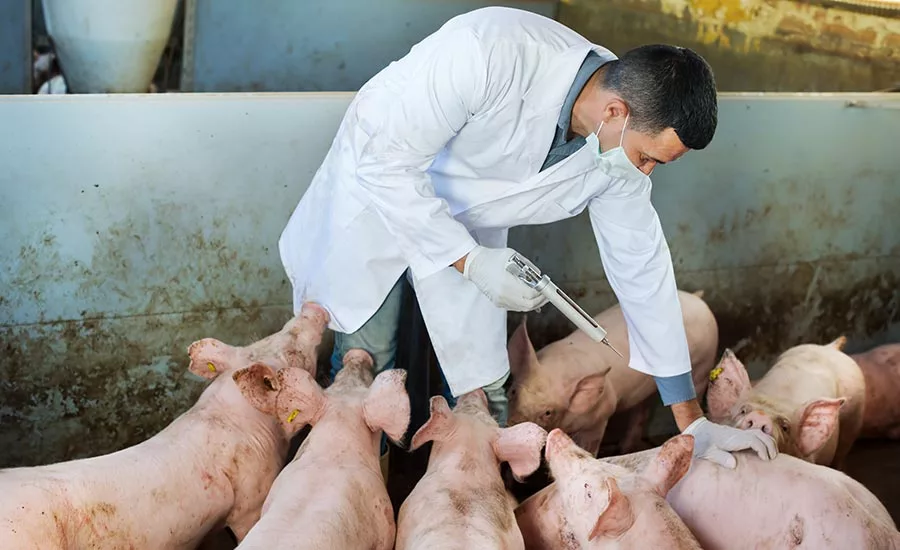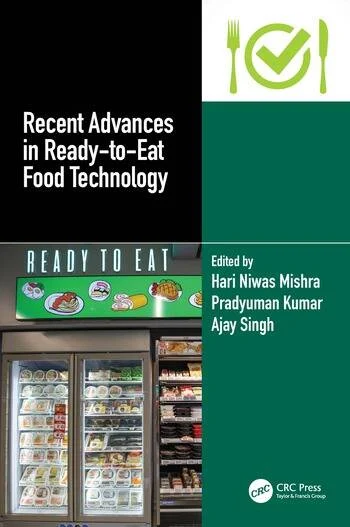Manufacturing News
Decreasing antibiotic use in food animals proves difficult to track
The UK has made progress with monitoring techniques, but tracking antibiotic use in the U.S. is problematic

Tracking antibiotic use in food animals such as pigs in the United States is complicated by the fact that no one agency tracks the data.
Getty Images/JackF
The UK pig industry has continued to reduce its use of antibiotics (aka antimicrobials), with the latest figures showing a 5% fall-off in the first half of 2020, reports the UK’s Agriculture Horticulture Development Board (AHDB), a statutory levy board funded by farmers, growers and others in the supply chain. The U.S., however, has also made progress in decreasing unnecessary antimicrobials in food animals, but the information is more difficult to obtain—and usually by inference—as there is no one agency that records the data.
In the UK, between the first of January 2020 and the end of June 2020, antibiotic usage in pigs dropped from 110 mg/PCU to 104 mg/PCU, making a significant step toward the 99 mg/PCU target set in 2017. This measurement is also known as the “intensity of antibiotic consumption,” expressed in milligram of antibiotic per kilogram of marketable meat.
The mg/PCU is a unit of measurement developed by the European Medicines Agency to monitor antibiotic use and sales across Europe, which has also been adopted by the UK in its national reports. PCU refers to the Population Correction Unit and takes into account the animal population as well as the estimated weight of each particular animal at the time of treatment with antibiotics.
For example, a 50 mg/PCU figure for food producing animals would mean that on average, and during the course of a year, 50 mg of antibiotic active ingredient was used for every kg of bodyweight at time of treatment.
The challenge of accurate numbers
While the FDA developed the Veterinary Feed Directive in 2015 [1] to curb the use of antibiotics as “growth promoters,” nevertheless, tracking the sanctioned use of antibiotics in food animals in the U.S. has been problematic. A paper published in the U.S., entitled, “Antimicrobial use in wean to market pigs in the United States assessed via voluntary sharing of proprietary data,” (Peter Davies and Randall Singer), described the issues involved with attempting to come up with an intensity figure of mg/kg in just the pork industry. [2]
According to a Michigan State University paper, since the implementation of FDA’s Veterinary Feed Directive in January 2017, overall sales of medically important antibiotics approved for use in livestock has actually declined by 43% from a peak in 2015. [3]
FE spoke with Derek Armstrong, lead veterinary science expert for UK’s AHDB, to understand the issues with metrics in determining antibiotic use in livestock. “One of the problems is that it’s quite difficult to compare antibiotic use between countries because people don’t necessarily use the same metrics,” Referring to the paper published by Peter Davies and Randall Singer, Armstrong says the authors don’t even put a figure on the amount antibiotics used in total in the U.S. Instead, they give a figure for each type of antibiotics used in mg/kg of carcass weight.
“When you talk about mg/kg, it depends on how many kg of pig you use as your denominator. So in their study, Davies and Singer looked at using the market weight of the pig as the total weight of pigs [in the U.S.], whereas in Europe, we use the population correction unit (PCU). So a market weight of pigs would probably be around just under 100 kg, but in Europe they look at the pig as weighing an average of 65 kg over its lifetime. So it’s not easy to compare mg/kg when its mg/kg of a 90 kg pig vs. mg/kg of a 65 kg pig,” Armstrong adds.
The UK has figured out a way to get accurate reporting of antimicrobial usage in at least the pig industry. When asked if farms in the UK have to report antimicrobial usage, Armstrong replied, “In the UK, they do. So as part of our farm assurance scheme, they’re required to report their usage of antibiotics every quarter to a database, which has been built by our organization, the Agriculture and Horticulture Development Board. I think in part that has helped generate a focus on what’s been happening on farms.”
“So we’ve gone from the mid-200s (mg/kg) down to close to a hundred within probably two years,” says Armstrong. “We’ve more than halved within two years. That’s because people started thinking about what they were doing—instead of adopting a lazy attitude like ‘we’ve done that because we’ve always done that.’” Farmers now consider more carefully the unnecessary use of antibiotics.
How does the U.S. compare with the UK in reducing antibiotic usage in pork? Armstrong did some rough calculating for the year 2018. “I came up with a figure around close to 250 mg/kg. So roughly in 2018, you (U.S.) would have been where the UK was in 2015. But you were on a downward journey as well.”
What’s the impact of the reduction in the use of antimicrobials in pigs in the UK? Armstrong says, there may be some cost involved. “Now, there has been probably an impact on the health of the animals. I spoke to one farmer who said they saved £100,000 in antibiotic bills, but then lost £100,000 in terms of animal performance. So it was a zero sum game.”
Has the U.S. kept up?
Unfortunately, according to a 2018 report from the Natural Resources Defense Council (NRDC), the U.S. scored higher for the intensity of antibiotic consumption in all livestock than most countries in Europe, except for Italy and Spain. The NRDC report, entitled “Antibiotic Consumption in the U.S. Pork, Beef, and Turkey Industries Vastly Outstrips Comparable Industries in Europe, and the U.S. Chicken Industry,” shows the U.S. in 2016 had an average score for all livestock of 242.8 mg/kg, only lower than Italy (294.8 mg/kg) and Spain (362.5 mg/kg). In fact, the figure of 242.8 mg/kg in the U.S. is 95% greater than the combined figure (124.6 mg of antibiotic per kg of livestock) for 30 European countries, including Italy and Spain. [4]
The 2018 NRDC study further reports that in 2016, U.S. intensity of antibiotic consumption was only 41 mg/kg for chicken; cattle weighed in at 241 mg/kg and pork scored a rating of 345 mg/kg, while turkey was practically off the charts at 474 mg/kg. In referring to these numbers, NRDC notes: According to FDA’s “2016 Summary Report on Antimicrobials,” beef production consumed 3,610,943 kilograms of medically important antibiotics, followed by 3,133,262 kilograms in pig production, 756,620 kilograms in turkey production and 508,500 kilograms in chicken.
Keeping animal antibiotics out of food and humans
When asked what level of antibiotics the UK Food Standards Agency (FSA) allows in pork at the grocery store, Armstrong replied, “Zero. All antibiotics have a withdrawal period. So that’s the time when the pig’s body would process it and eliminate it from the body. You’re not allowed to sell the animal if it’s been treated, and it’s still within that withdrawal period. I guess it would be the same situation in the USA.”
The USDA, indeed, does have a monitoring program, and it is illegal to sell any meats containing an antimicrobial or any chemical above a maximum residual level (MRL). Imported meats must meet the same criteria as domestic meats in the U.S. [5]
“But essentially, there is a monitoring program as well; [FSA] will take samples at random and test those for antibiotics,” says Armstrong. “I think in general, 99% of samples will pass that test. And even some of the ones that fail will still be below the maximum residue limit, but [FSA] will investigate those as well. So essentially—whether it’s milk or meat—there should be no antibiotics in the food that we eat.”
There are two reasons to keep antibiotics out of food, says Armstrong. First is making sure there aren’t any residues left in the food we eat, and second, to minimize antibiotic resistance. “With our residue testing program, and not sending animals to slaughter until they completed their withdrawal period, the first should be a relatively small problem,” he says. And keeping unnecessary antimicrobials out of the environment in general means that bacteria will develop resistance more slowly, making antimicrobials more effective when actually needed.
References
[1] “Veterinary Feed Directive (VFD): Final Rule,” 2015, 2019; FDA Web Site
[2] “Antimicrobial use in wean to market pigs in the United States assessed via voluntary sharing of proprietary data;” Peter R. Davies and Randall S. Singer; 17 November 2020; Zoonoses and Public Health, Vol. 67, Issue S1, https://doi.org/10.1111/zph.12760.
[3] “Antibiotic use in swine production,” Casey Zangaro, Michigan State University Extension - May 15, 2019
[4] “Antibiotic Consumption In U.S. Pork, Beef, And Turkey Industries Vastly Outstrips Comparable Industries In Europe, And The U.S. Chicken Industry,” Natural Resources Defense Council (NRDC), Nov. 2018
[5] “The Truth About: Meat and Antibiotics,” Minnesota Antibiotic Stewardship Collaborative, 8/19/2019.
For additional consideration:
“Understanding the mg/PCU calculation used for antibiotic monitoring in food producing animals,” 28 DEC 2016, Veterinary Medicines Directorate, Guidance document from GOV.UK.
“Antibiotic Use in Agriculture and Its Consequential Resistance in Environmental Sources: Potential Public Health Implications;” Christy Manyi-Loh, Sampson Mamphweli, Edson Meyer, and Anthony Okoh; Molecules, 2018 Apr; 23(4): 795; US National Library of Medicine, NIH.
“Antibiotic/Antimicrobial Resistance (AR/AMR): Food and Food Animals;” CDC
“FACT SHEET: Veterinary Feed Directive Final Rule and Next Steps,” FDA, (2-25-2-20), FDA Website
“Patterns of antibiotic use in global pig production: A systematic review,” ScienceDirect, June 2019
“Huge levels of antibiotic use in US farming revealed,” The Guardian, 8 FEB 2018
“Maximum Residue Limits (Mrls) And Risk Management Recommendations (RMRs) For Residues Of Veterinary Drugs In Foods, Codex Alimentarius, CX/MRL 2-2018
“Maximum Residue Limits (MRL) Database,” USDA, Website accessed 2021.
“Food Safety and Inspection Service Annual Sampling, Program Plan Fiscal Year 2020,” FY 2020, USDA Website (accessed 7 Jan 2021).
Looking for a reprint of this article?
From high-res PDFs to custom plaques, order your copy today!









